If you find Complexity Thoughts interesting, follow us! Click on the Like button, leave a comment, repost on Substack or share this post. It is the only feedback I can have for this free service. The frequency and quality of this newsletter relies on social interactions. Thank you!
Foundations of network science and complex systems
Ghost Channels and Ghost Cycles Guiding Long Transients in Dynamical Systems
Dynamical descriptions and modeling of natural systems have generally focused on fixed points, with saddles and saddle-based phase-space objects such as heteroclinic channels or cycles being central concepts behind the emergence of quasistable long transients. Reliable and robust transient dynamics observed for real, inherently noisy systems is, however, not met by saddle-based dynamics, as demonstrated here. Generalizing the notion of ghost states, we provide a complementary framework that does not rely on the precise knowledge or existence of (un)stable fixed points, but rather on slow directed flows organized by ghost sets in ghost channels and ghost cycles. Moreover, we show that the appearance of these novel objects is an emergent property of a broad class of models typically used for description of natural systems.
Generalized Dynamical Mean Field Theory for Non-Gaussian Interactions
We present a generalized dynamical mean field theory for studying the effects of non-Gaussian quenched noise in a general set of dynamical systems. We apply the framework to the generalized Lotka-Volterra equations, a central model in theoretical ecology, where species interactions are fixed over time and heterogeneous. Our results show that the new mean field equations have solutions that depend on all cumulants of the distribution of species interactions. We obtain an analytic solution when the interaction couplings are 𝛼-stable distributed and find a relationship between the abundance distribution of species and the statistics of microscopic interactions. In the case of sparse interactions, which we investigate analytically, we establish a simple relationship between the distribution of interactions and the one of population densities.
Evolution
Adaptive radiation during the evolution of complex multicellularity

The evolution of multicellularity led to the origin of new kinds of organisms and, in several lineages, massive adaptive radiations through the formation of entirely new ecosystems. This paper examines three key mechanisms underpinning parallel adaptive radiations within the five clades of ‘complex’ multicellularity: animals, land plants, fungi, red algae, and brown algae. First, the evolution of key multicellular innovations permitted diversification into new ecological roles. Second, the evolution of large multicellular organisms with strong genetic bottlenecks between generations fundamentally changed the population genetic context of evolution, greatly reducing effective population size and increasing the role of genetic drift. This may be beneficial during adaptive radiations, underpinning nonadaptive expansions of genome size and allowing broader exploration of multicellular trait space. Finally, we explore how evolutionary priority effects provide a first-mover advantage, maintaining ancient adaptive radiations over long time periods by suppressing competition from convergently evolving multicellular taxa. Investigating parallel patterns of diversification across independent origins of complex multicellularity provides insight into the principles underpinning these crucially important adaptive radiations.
An interesting, alternative, perspective: can complexity decrease and then stabilize?
The eye and brain: standard thinking is that these devices are both complex and functional. They are complex in the sense of having many different types of parts, and functional in the sense of having capacities that promote survival and reproduction. Standard thinking says that the evolution of complex functionality proceeds by the addition of new parts, and that this build-up of complexity is driven by selection, by the functional advantages of complex design. The standard thinking could be right, even in general. But alternatives have not been much discussed or investigated, and the possibility remains open that other routes may not only exist but may be the norm. Our purpose here is to introduce a new route to functional complexity, a route in which complexity starts high, rising perhaps on account of the spontaneous tendency for parts to differentiate. Then, driven by selection for effective and efficient function, complexity decreases over time. Eventually, the result is a system that is highly functional and retains considerable residual complexity, enough to impress us. We try to raise this alternative route to the level of plausibility as a general mechanism in evolution by describing two cases, one from a computational model and one from the history of life.
Towards High Evolvability Dynamics Introduction
Some organizations are more friendly to evolution than others. Biological systems, since they are the products of evolution, must fall into the friendly class. Computer programs are at the opposite extreme. They are too fragile, at the level of base code, for random changes to produce acceptable new code with any reasonable degree of probability.
Mass extinction has often paved the way for rapid evolutionary radiation, resulting in the emergence of diverse taxa within specific lineages. The emergence and diversification of carnivorous nematode-trapping fungi (NTF) in Ascomycota have been linked to the Permian-Triassic (PT) extinction, but the processes underlying NTF radiation remain unclear. We conducted phylogenomic analyses using 23 genomes that represent three NTF lineages, each employing distinct nematode traps—mechanical traps (Drechslerella spp.), three-dimensional (3D) adhesive traps (Arthrobotrys spp.), and two-dimensional (2D) adhesive traps (Dactylellina spp.), and the genome of one non-NTF species as the outgroup. These analyses revealed multiple mechanisms that likely contributed to the tempo of the NTF evolution and rapid radiation. The species tree of NTFs based on 2,944 single-copy orthologous genes suggested that Drechslerella emerged earlier than Arthrobotrys and Dactylellina. Extensive genome-wide phylogenetic discordance was observed, mainly due to incomplete lineage sorting (ILS) between lineages. Two modes of non-vertical evolution (introgression and horizontal gene transfer) also contributed to phylogenetic discordance. The ILS genes that are associated with hyphal growth and trap morphogenesis (e.g., those associated with the cell membrane system and polarized cell division) exhibited signs of positive selection.
Artificial Intelligence
This paper is just exciting: artificial neural networks have intrinsic limitations, and they are related to complexity.
We find a sharp transition from a learnable phase to an unlearnable phase as the latent space entropy of the discrete CA functions increases
The extraordinary success of convolutional neural networks (CNNs) in various computer vision tasks has revitalized the field of artificial intelligence. The out-sized expectations created by this extraordinary success have, however, been tempered by a recognition of CNNs’ fragility. Importantly, the magnitude of the problem is unclear due to a lack of rigorous benchmark datasets. Here, we propose a solution to the benchmarking problem that reveals the extent of the vulnerabilities of CNNs and of the methods used to provide interpretability to their predictions. We employ cellular automata (CA) to generate images with rigorously controllable characteristics. CA allow for the definition of both extraordinarily simple and highly complex discrete functions and allow for the generation of boundless datasets of images without repeats. In this work, we systematically investigate the fragility and interpretability of the three popular CNN architectures using CA-generated datasets. We find a sharp transition from a learnable phase to an unlearnable phase as the latent space entropy of the discrete CA functions increases. Furthermore, we demonstrate that shortcut learning is an inherent trait of CNNs. Given a dataset with an easy-to-learn and strongly predictive pattern, CNN will consistently learn the shortcut even if the pattern occurs only on a small fraction of the image. Finally, we show that widely used attribution methods aiming to add interpretability to CNN outputs are strongly CNN-architecture specific and vary widely in their ability to identify input regions of high importance to the model. Our results provide significant insight into the limitations of both CNNs and the approaches developed to add interpretability to their predictions and raise concerns about the types of tasks that should be entrusted to them.
Biological Systems
Irreversibility in bacterial regulatory networks
Irreversibility, in which a transient perturbation leaves a system in a new state, is an emergent property in systems of interacting entities. This property has well-established implications in statistical physics but remains underexplored in biological networks, especially for bacteria and other prokaryotes whose regulation of gene expression occurs predominantly at the transcriptional level. Focusing on the reconstructed regulatory network of Escherichia coli, we examine network responses to transient single-gene perturbations. We predict irreversibility in numerous cases and find that the incidence of irreversibility increases with the proximity of the perturbed gene to positive circuits in the network. Comparison with experimental data suggests a connection between the predicted irreversibility to transient perturbations and the evolutionary response to permanent perturbations.
Neuroscience
Functional neuronal circuits emerge in the absence of developmental activity
The complex neuronal circuitry of the brain develops from limited information contained in the genome. After the genetic code instructs the birth of neurons, the emergence of brain regions, and the formation of axon tracts, it is believed that temporally structured spiking activity shapes circuits for behavior. Here, we challenge the learning-dominated assumption that spiking activity is required for circuit formation by quantifying its contribution to the development of visually-guided swimming in the larval zebrafish. We found that visual experience had no effect on the emergence of the optomotor response (OMR) in dark-reared zebrafish. We then raised animals while pharmacologically silencing action potentials with the sodium channel blocker tricaine. After washout of the anesthetic, fish could swim and performed with 75–90% accuracy in the OMR paradigm. Brain-wide imaging confirmed that neuronal circuits came ‘online’ fully tuned, without requiring activity-dependent plasticity. Thus, complex sensory-guided behaviors can emerge through activity-independent developmental mechanisms.
The uniqueness of human vulnerability to brain aging in great ape evolution
Aging is associated with progressive gray matter loss in the brain. This spatially specific, morphological change over the life span in humans is also found in chimpanzees, and the comparison between these great ape species provides a unique evolutionary perspective on human brain aging. Here, we present a data-driven, comparative framework to explore the relationship between gray matter atrophy with age and recent cerebral expansion in the phylogeny of chimpanzees and humans. In humans, we show a positive relationship between cerebral aging and cortical expansion, whereas no such relationship was found in chimpanzees. This human-specific association between strong aging effects and large relative cortical expansion is particularly present in higher-order cognitive regions of the ventral prefrontal cortex and supports the “last-in-first-out” hypothesis for brain maturation in recent evolutionary development of human faculties.
(Human) behavior
Intrinsic Motivation in Dynamical Control Systems
Biological systems often choose actions without an explicit reward signal, a phenomenon known as intrinsic motivation. The computational principles underlying this behavior remain poorly understood. In this study, we investigate an information-theoretic approach to intrinsic motivation, based on maximizing an agent's empowerment (the mutual information between its past actions and future states). We show that this approach generalizes previous attempts to formalize intrinsic motivation, and we provide a computationally efficient algorithm for computing the necessary quantities. We test our approach on several benchmark control problems, and we explain its success in guiding intrinsically motivated behaviors by relating our information-theoretic control function to fundamental properties of the dynamical system representing the combined agent-environment system. This opens the door for designing practical artificial, intrinsically motivated controllers and for linking animal behaviors to their dynamical properties.
Neural populations in the language network differ in the size of their temporal receptive windows
Despite long knowing what brain areas support language comprehension, our knowledge of the neural computations that these frontal and temporal regions implement remains limited. One important unresolved question concerns functional differences among the neural populations that comprise the language network. Here we leveraged the high spatiotemporal resolution of human intracranial recordings (n = 22) to examine responses to sentences and linguistically degraded conditions. We discovered three response profiles that differ in their temporal dynamics. These profiles appear to reflect different temporal receptive windows, with average windows of about 1, 4 and 6 words, respectively. Neural populations exhibiting these profiles are interleaved across the language network, which suggests that all language regions have direct access to distinct, multiscale representations of linguistic input—a property that may be critical for the efficiency and robustness of language processing.


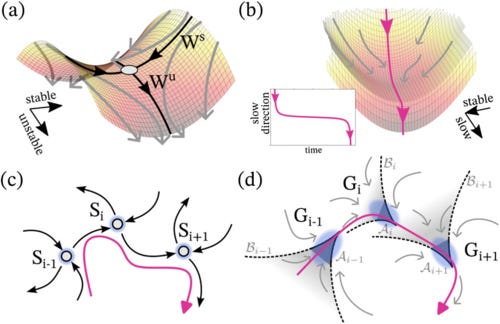

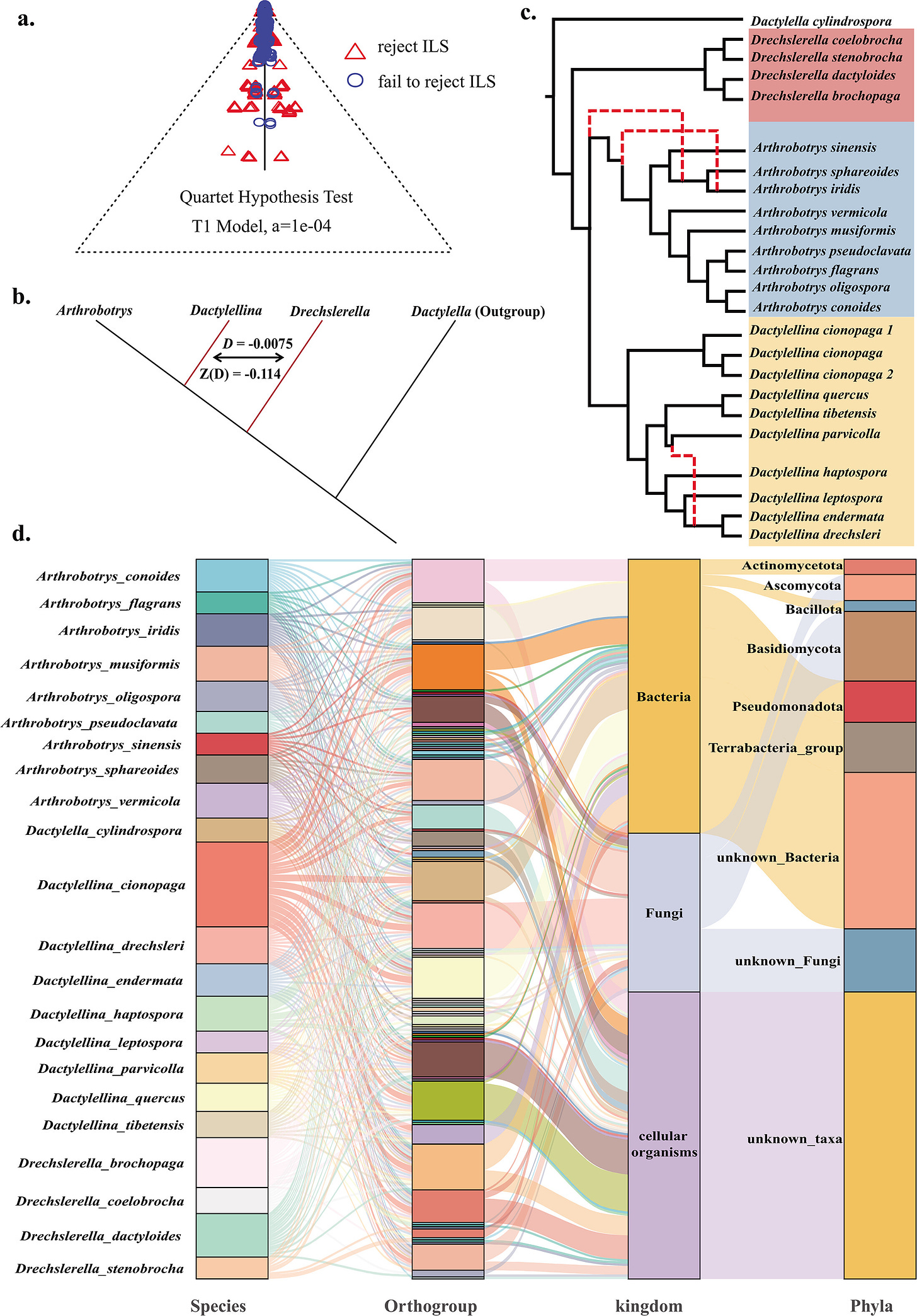
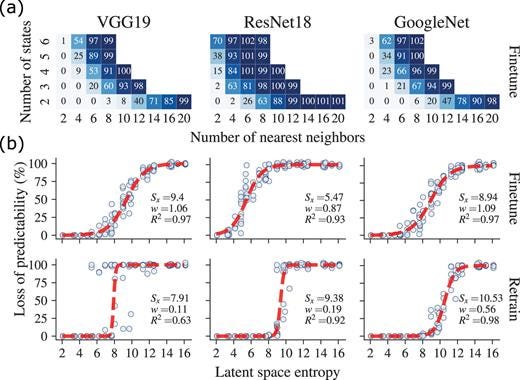
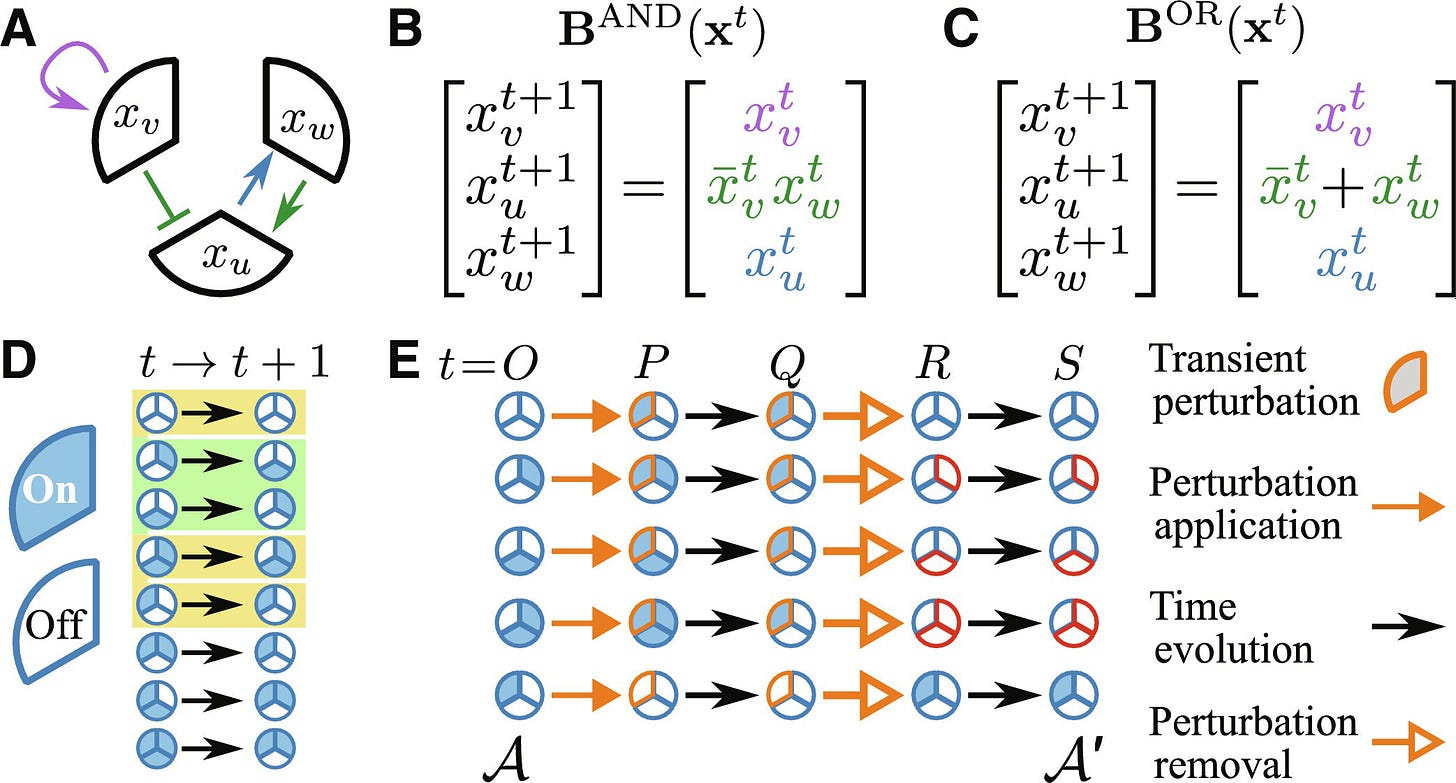


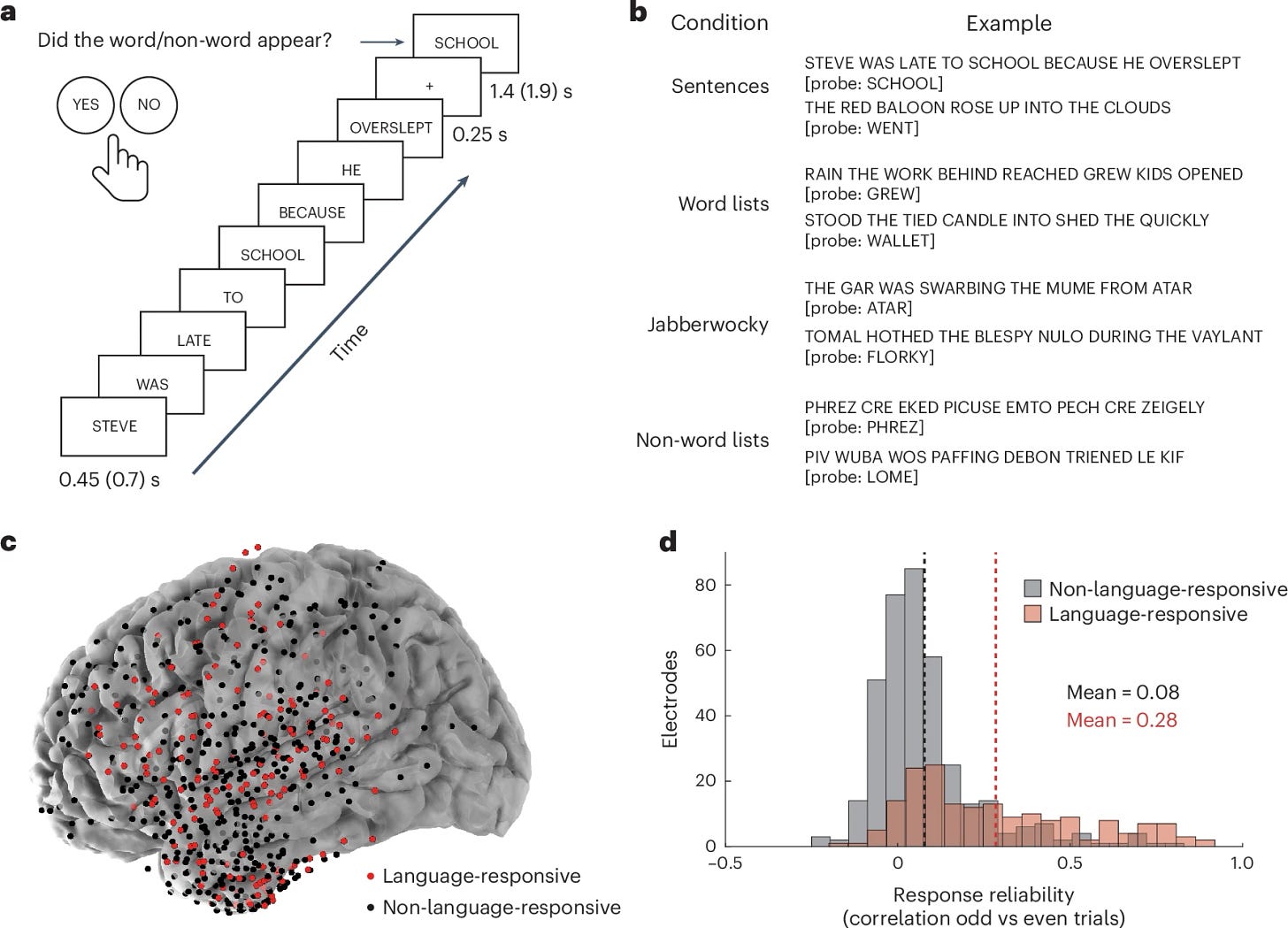
Very interesting read thanks! Did you have a link to the images under the Biological Systems section?